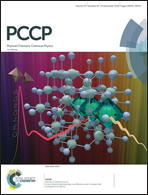Deformation behavior of an amorphous zeolitic imidazolate framework – from a supersoft material to a complex organometallic alloy†
Abstract
Zeolitic imidazolate frameworks (ZIFs)—a subset of metal–organic frameworks (MOFs)—have recently attracted immense attention. Many crystalline ZIFs (c-ZIFs) have highly porous zeolite structures that are ideal for molecular encapsulation. Recently emerging non-crystalline or amorphous ZIFs (a-ZIFs) with a similar short-range order are of interest because they can be converted from c-ZIFs for large-scale production. Here, we present a computational study of the deformation behavior of a unique a-ZIF model by simulating step-wise compression and expansion with strains between −0.389 and +0.376. An insulator-to-metal transition is observed at 51 GPa leading to a multicomponent light amorphous alloy of only 3.68 g (cm)−3. A high-density amorphous-to-amorphous phase transition is observed due to the sudden formation of N–N bond pairs. The systematic expansion of the a-ZIF retains the framework softness until it fractures at high strain. Based on the expansion data, we propose an empirical formula for super-soft materials, which is in line with available experimental data.



 Please wait while we load your content...
Please wait while we load your content...